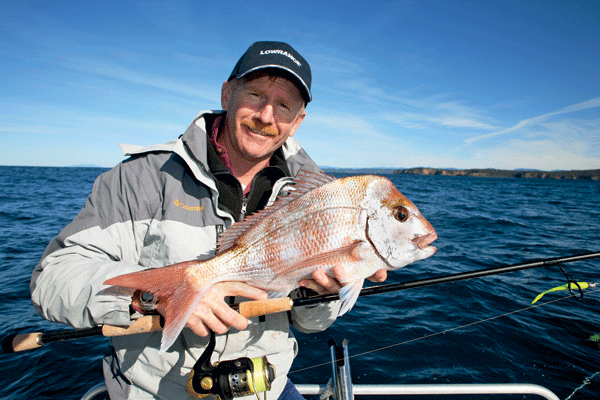FISHING SCHOOL
Which Outfit – Part II
This month Pat details the advantages and applications of four different “balanced outfits”.
AS I detailed last month, a balanced outfit combines a rod, reel and line that are all suited. But what types of outfit will do the job best? Here’s a basic explanation of the outfits you might expect to encounter in your local tackle shop and what they are best suited for.
Light threadline
This would have to be the most common fishing outfit in the world. It’s simply a smallish threadline reel in the 1000 to 3000 size and a relatively short rod of 1.5 to two metres in length.
The most popular line classes for such an outfit would be two to four kilo. An outfit like this is well suited to bait fishing, lure casting and trolling. The applications it would be good for include river and lake trout fishing, as well as other kinds of inland fishing for species like bass, golden and silver perch, redfin or carp. The same outfit can also be used for the majority of general southern estuary work including for bream, whiting, luderick and flathead. This single-handed threadline outfit is probably the most versatile rod/reel combo available. While not really suited to targeting larger quarry such as jewfish or Murray cod, a light threadline outfit can land huge fish – when in the right hands! Threadline reels of the sizes mentioned above are affordable, easy to use and are very versatile in that they are great for casting very light lures or unweighted baits.
Heavy threadline
This sort of outfit usually means a larger, stronger reel in sizes 4000 to 10000, depending on the application and line breaking strain used. Lines classes for these outfits may range from between four or six kilos right up to 60kg. For these types of outfits, the rod may fall into several different categories. Firstly, longer rods in the three to four metre range are best suited for beach and rock fishing scenarios. The longer rods enable you to make the lengthy casts these forms of fishing often demand.
The extra rod length assists in keeping the line out of turbulent water which creates slack line, which reduces your ability to detect bites. Other rods that fall into this category include 4-8kg, 1.9 to 2.2m models suited to inshore snapper fishing or estuary jewfishing. Then you have more powerful rods used in offshore applications, such as tropical popper fishing or deepwater jigging. These stronger rods can be capable of fishing line classes up to 60kg. The line class determines how powerful the rod needs to be. Rods for this application are usually between 1.3 and 2.2m in length. Any longer than this and they become awkward to use in the confined spaces of a boat. The larger reels are capable of storing more line of the heavier line classes and are more robust and capable of battling larger fish. The quality of the drag system in such a reel needs to be up to the task that you are putting it to.
Light baitcaster
A single-handed overhead rod is designed to complement a baitcast or overhead reel. Rods are typically 1.6-2m in length. This type of outfit is specifically designed for short to medium range lure casting. During the cast with an overhead reel, the line should always be under control, whereas with threadline reels the line generally spews out and over the lip of the reel spool. Therefore, when the line is under control throughout the cast pinpoint accuracy is more easily achieved. However, this principle of line control is easier said than done. Many people have a great deal of trouble when first using these reels in the form of massive tangles known as “bird’s nests”.
These often lead to these reels being put on sale on the second hand market not long after being purchased.The rod is not too dissimilar to that used by the single handed threadline outfit, except for the fact that the overhead reel, as the name suggests, sits on top of the rod. To minimise friction on the line there are more guides on an overhead rod. Also, the handle for these rods will often have a trigger like configuration where the reel is mounted. This fitting gives the angler greater control of the rod during the cast.
Heavy baitcaster
This outfit is simply a bigger version of the above. The size can vary, however, from a slightly larger outfit involving a heavier weight rod used for targeting Murray cod or barramundi to much larger reels on a 3.5-4m rod for beach and rock fishing. In the hands of an accomplished caster, these reels are capable of casting greater distances than any other outfit.
They are also well suited to controlling big fish and are commonly used by rock fishing enthusiasts for casting lures or livebaits for kingfish, tuna, mackerel and jewfish. The larger versions of the overhead outfit usually will not have the trigger fitting on the handle common on lighter versions.Well, there you have it. A bit of a quickie, I know, but hopefully there’s enough there to help you when you’re shopping around for some new tackle this summer.

















